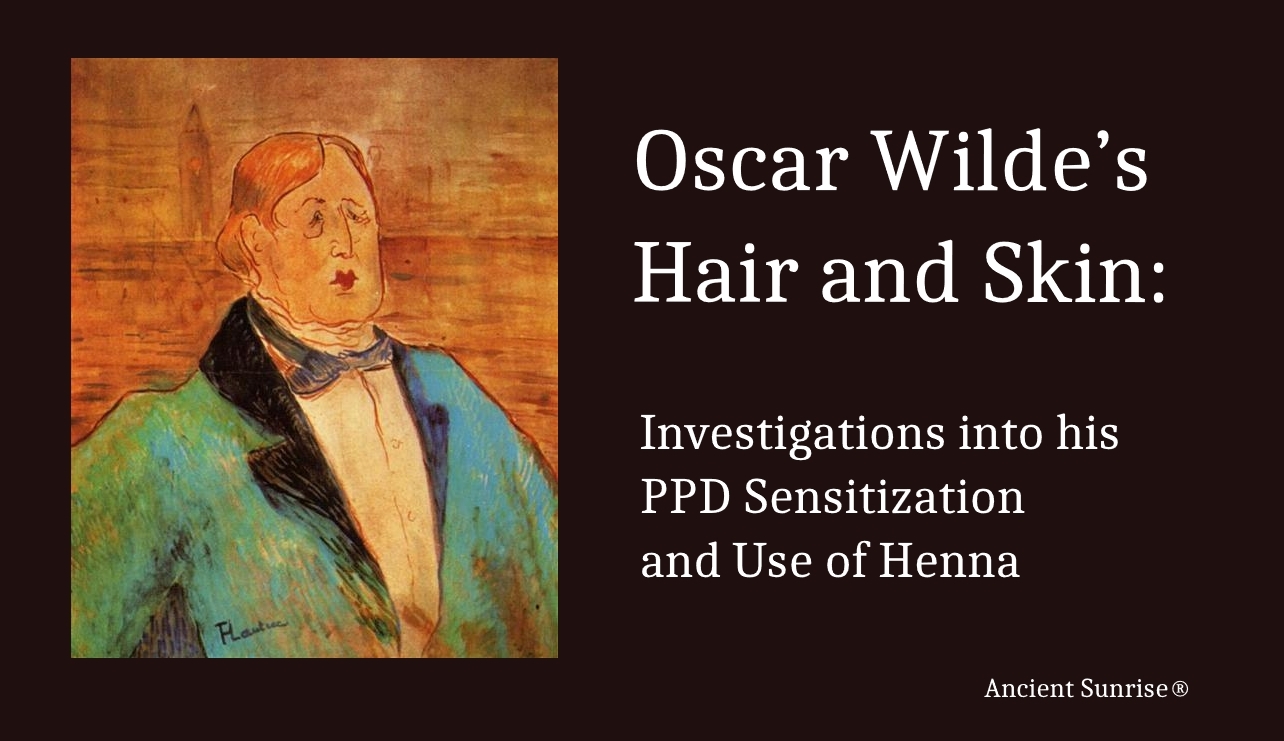
Oscar Wilde, famous novelist, poet, and playwright, lived a short and scandalous life during the turn of the 20th century, from 1854 to 1900. He is believed to be one of the first famous people to have had an allergy to para-phenylenediamine (PPD) from hair dye. His personal accounts and those from his friends and biographers leave no doubt that Wilde was prematurely gray, and that he used hair dye to cover his increasingly white hair. A study of paintings and drawings done of Wilde suggest that he may have tried henna products, as well.
Oscar Wilde is known for works such as “The Picture of Dorian Gray,” “A House of Pomegranates,” and “The Importance of Being Earnest.” Having died at the young age of 46, he was in his lifetime no doubt prolific. He once wrote a play entirely in French, which, according to scholars, showed barely any trace of having been written by a non-native speaker. [2]
However, during his lifetime, Wilde’s accomplishment as a writer was overshadowed by his notorious propensity for eating, drinking, and “sexual inversion” [1]. He was put to trial multiple times under the crime of homosexuality, and eventually imprisoned for two years from 1895 to 1897.
At the time of his death, the cause was believed to be neurosyphilis, exacerbated by his gluttony and alcoholism. His reputation made such a diagnosis more than plausible. However, more recent medical professionals believed that the cause of his death was more likely to be a chronic ear infection which eventually spread to the brain. [1]
Besides the worsening illness that eventually took his life, Wilde also suffered from a recurring rash that itched intensely and spread over his face, arms, back, and chest. This rash could not have been due to syphilis; syphilitic rashes do not itch. Wilde himself attributed it to some bad mussels he once ate. However the rash would disappear and reappear periodically for the rest of his life. The description of the rash was not consistent with an allergy to mussels. Scholars and medical professionals believe that this rash was more likely caused by a sensitization to para-phenylenediamine from the dye he used to mask his prematurely graying hair. [3] [4]
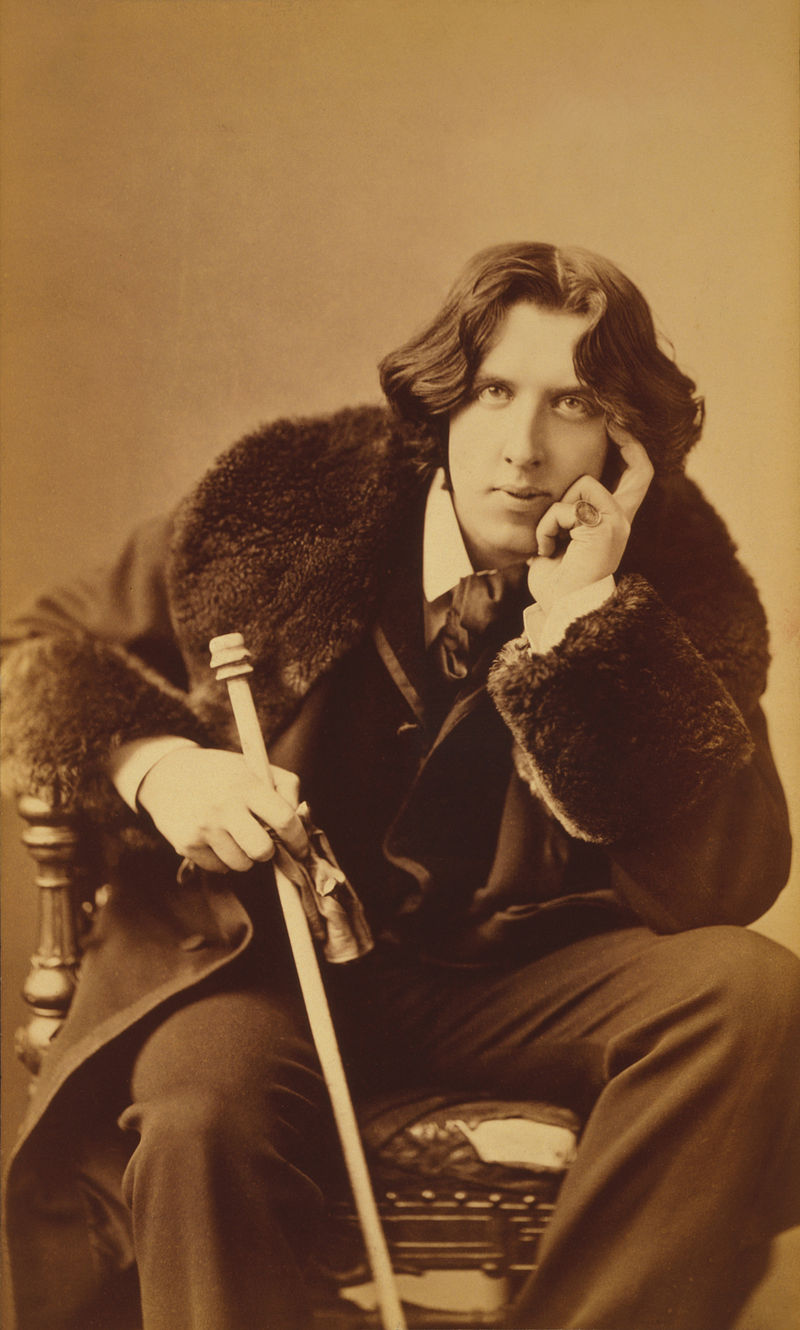
A younger Wilde, at age 28. (Keep the “favourite coat” part in mind for later.)
“Oscar Wilde in his favourite coat.” New York, 1882. Picture taken by Napoleon Sarony. Source: https://commons.wikimedia.org/wiki/Oscar_Wilde
Oscar Wilde’s Gray Hair: A Story in Letters, Photos, and Portraits
Photography during Wilde’s lifetime provides little help in determining the exact color of Wilde’s hair during his youth, the time when it began to gray, nor the exact shade to which he dyed it. Wilde himself was not likely to discuss his use of hair-dye, as he was exceptionally vain and was a lover of youth and beauty. For most of his life, his friends were largely unaware that he was graying, and he probably preferred it that way.
In order to pull together some information about Wilde’s hair, one can turn to written documents from Wilde’s close friends, and to the portraits painted of him.
In a letter written by Wilde’s friend, Robert Ross, to friend and biographer Frank Harris, Ross writes of Wilde’s hair during the month preceding his death.
Ross wrote, “I noticed for the first time that his hair was slightly tinged with grey. I had always remarked that his hair had never altered its colour while he was in Reading; it retained its soft brown tone. You must remember the jests he used to make about it, he always amused the warders by saying that his hair was perfectly white.”
Frank Harris responded, “I noticed at Reading that his hair was getting grey in front and at the sides; but when we met later, the grey had disappeared.” [4]
During the decline of his health, Wilde likely had trouble keeping up with dyeing his hair. This would have led to Ross’ remark. Reading Gaol (pronounced “Redding Jail”) was the prison in which he served most of his time. From the friends’ accounts, one could deduce that Wilde had some access to hair dye while in Reading, but maybe not as regularly, allowing Harris to witness Wilde’s gray from root growth or perhaps fading dye.
Information about Oscar Wilde’s changing hair color can also be gleaned from comparisons between paintings of Wilde in his early years and those of him from just prior to the time of his death. In the portrait below, done of Wilde when he was 27 years old, he has deep brown hair. In the photos, his hair also appears to be rather dark, perhaps a medium to dark brown.
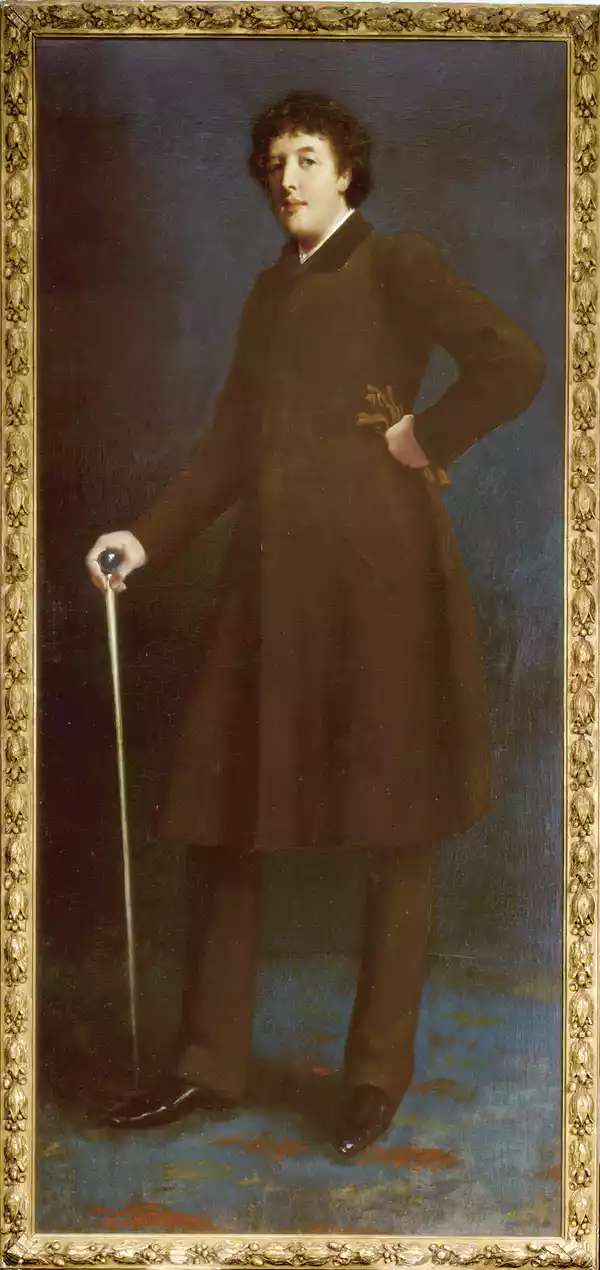
“Robert Goodloe Harper Pennington, “Portrait of Oscar Wilde.” 1881.
The photograph below, taken in 1882, would have shown Wilde at age 28. Again, it seems his hair is rather dark, and that Wilde was rather vain. It cannot be precisely determined when Wilde began to gray, and when he began to dye his hair, but there is a clear difference between the brunette tones seen in his early life and the bright, orange and blonde tones seen later.
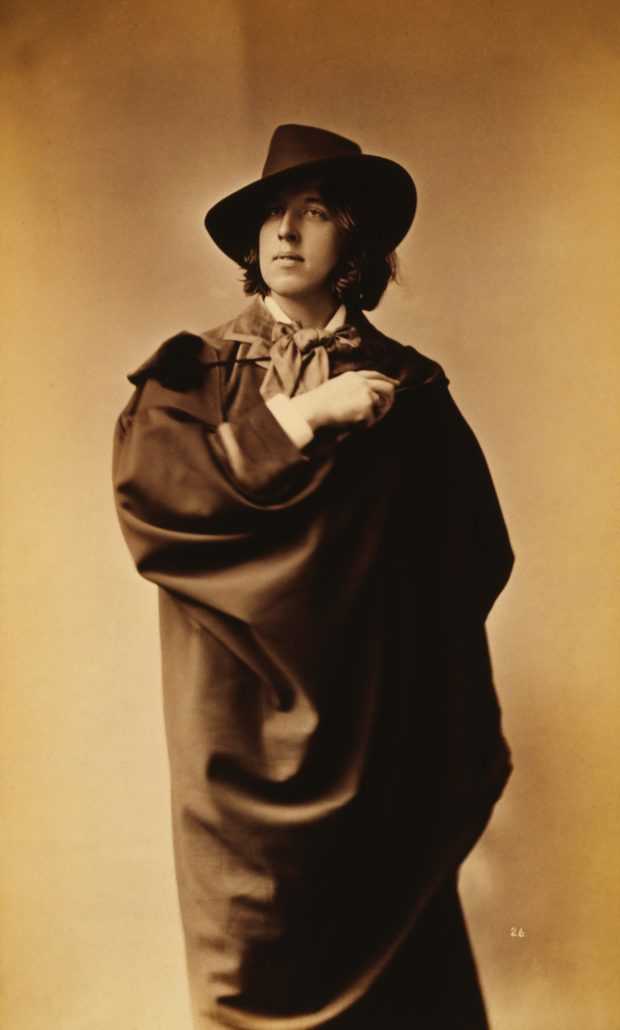
“Oscar Wilde by Napoleon Sarony, with hat and cape, 1882” Source: https://www.cmgww.com/historic/wilde/photos/
While Ross described Wilde’s hair as “soft brown” during his time in Reading Gaol, the following paintings show his hair to be a blonde to light copper color. It must be taken into account that artists are afforded their creative freedom in choosing color; however, it is interesting to note that both the portrait of Oscar Wilde by Toulous Lautrec and the works by Ricard Opisso show him with light hair.
The painting below is Lautrec’s portrait of Wilde, done in 1895 during the time of Wilde’s trial prior to his imprisonment. It is reported that Lautrec wanted Wilde to sit for the painting, but that this was done from memory.
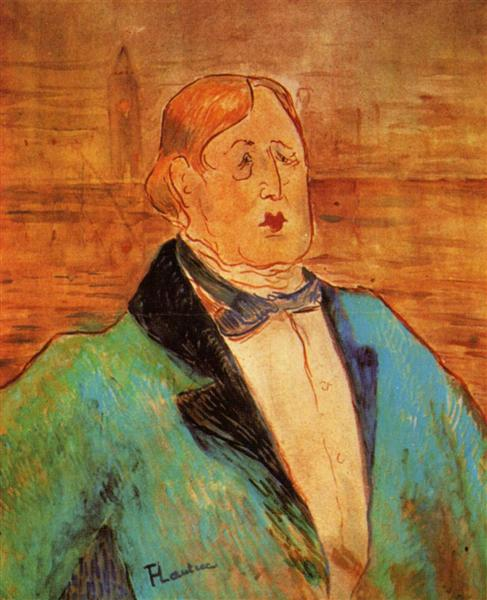
Henri de Toulous-Lautrec, “Portrait of Oscar Wilde.” 1895
Source: https://www.wikiart.org/en/henri-de-toulouse-lautrec/portrait-of-oscar-wilde-1895
Variations of this painting exist. It is possible that Lautrec himself painted or printed multiple versions, or that the color of the image was altered in other ways. Here is another version of the same portrait, and a section from the painting’s original sketch. Notice that even in the sketch, Wilde’s hair is not shaded in, but left light.
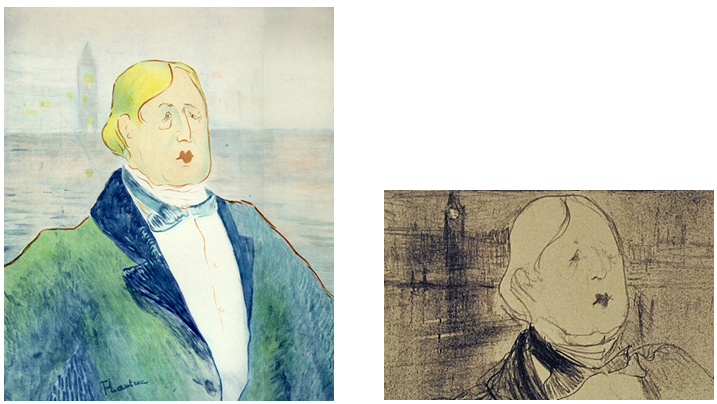
Sources: (left) http://flavorwire.com/414089/7-rediscovered-paintings-by-famous-artists/8
(right) https://commons.wikimedia.org/wiki/File:Wilde-1896-Toulouse-Lautrec.jpg
Ricard Opisso, Catalan artist and cartoonist, also drew and painted Oscar Wilde around the same time, often showing him with Lautrec in the cafes and dance halls where they spent much of their time.
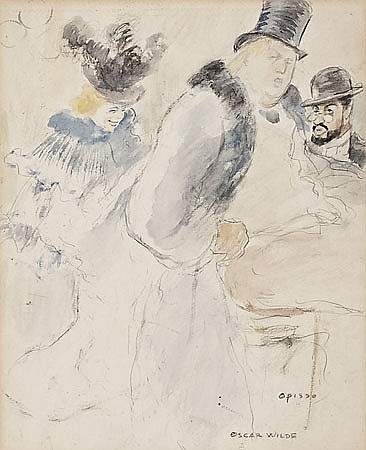
Ricard Opisso, “Oscar Wilde” 1880.
Source: https://www.invaluable.com/artist/opisso-sala-ricardo-hwcdvmmmp0
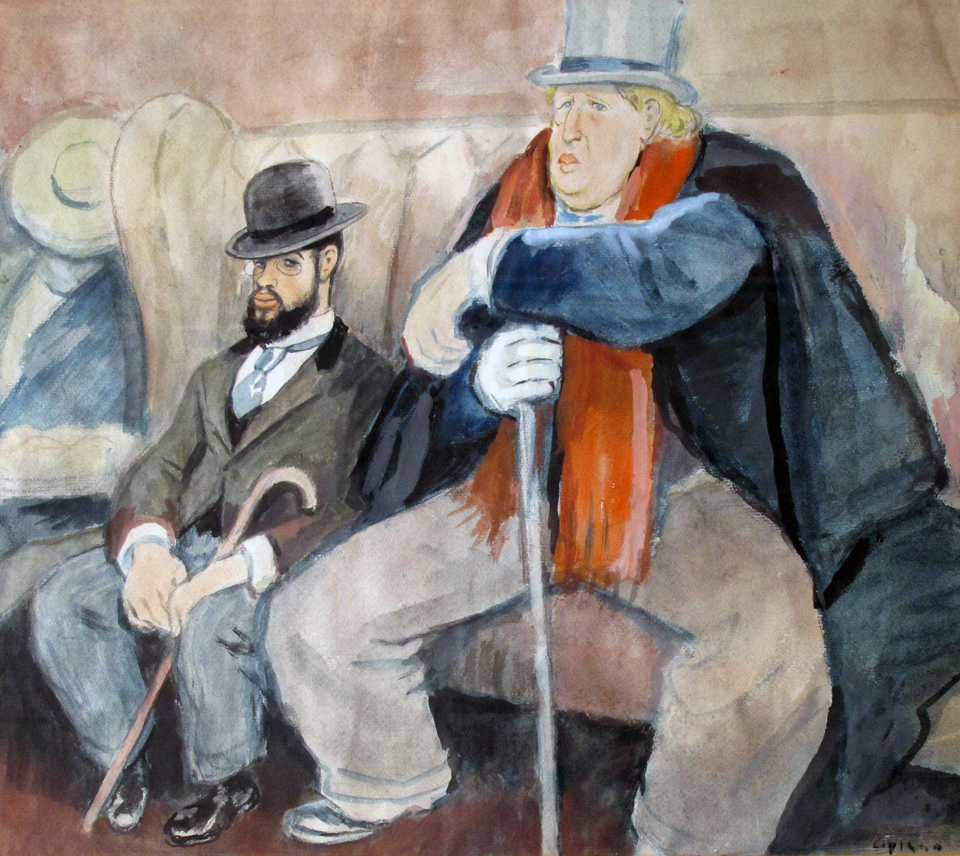
Oscar Wilde sits next to painter Toulouse Lautrec at a cafe. His hair in this painting is a deep yellow.
“Interior de cafè amb Toulouse Lautrec i Oscar Wilde” by Ricard Opisso. Not dated.
Source: Pinterest, saved from http://www.francescmestreart-shopping.com/en/?portfolio-item=ricard-opisso
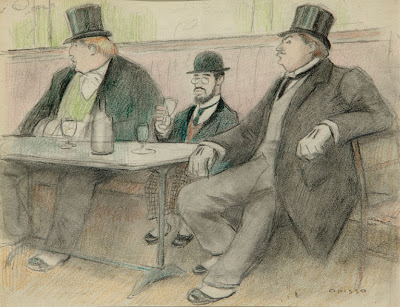
Here, The viewer sees Wilde to the left of Lautrec. His hair is an orange tone.
Ricard Opisso, title and date unknown. Source: http://www.artneutre.net/2006/12/airs-de-paris-reus.html
The two latter images above are not dated, but it can be assumed that Opisso created them around the same time as the first. They take place in Paris, where Wilde spent most of his time from 1880 to the end of his life, save for his stint in prison. Opisso himself was from Spain, and was only documented to have visited Paris, not to have spent any length of his time living there. Note that all of Oppiso’s images of Wilde show him with light copper or blond hair.
Did Oscar Wilde Use Henna, and If So, Why?
While there is no doubt that Oscar Wilde was prematurely gray and that he used hair dye to mask the fact, only guesses can be made about the kinds of hair dyes he used. A brunette during his younger life, he no doubt wished to maintain a similar hair color when he first began to gray.
Hair dyes available during the late 19th century had very little regulation. PPD was initially introduced as a fur dye in 1883, patented by a man from Paris, named P. Monnet et Cie. By the 1890s, it was adopted by hair stylists across the western world. The first commercially available PPD hair dye was produced in 1910, a decade after Wilde’s death. This means that if he had dyed his hair with a product containing PPD, it was either at a salon or with a dye labeled for use on fur. The latter is not a ridiculous thought, as products have always been used for purposes outside of their labels. Many early hair dyes were marketed for both hair and for fur. Wilde owned many articles of clothing made of fur. He would have purchased such products to maintain them, and could have used the rest on his own hair.
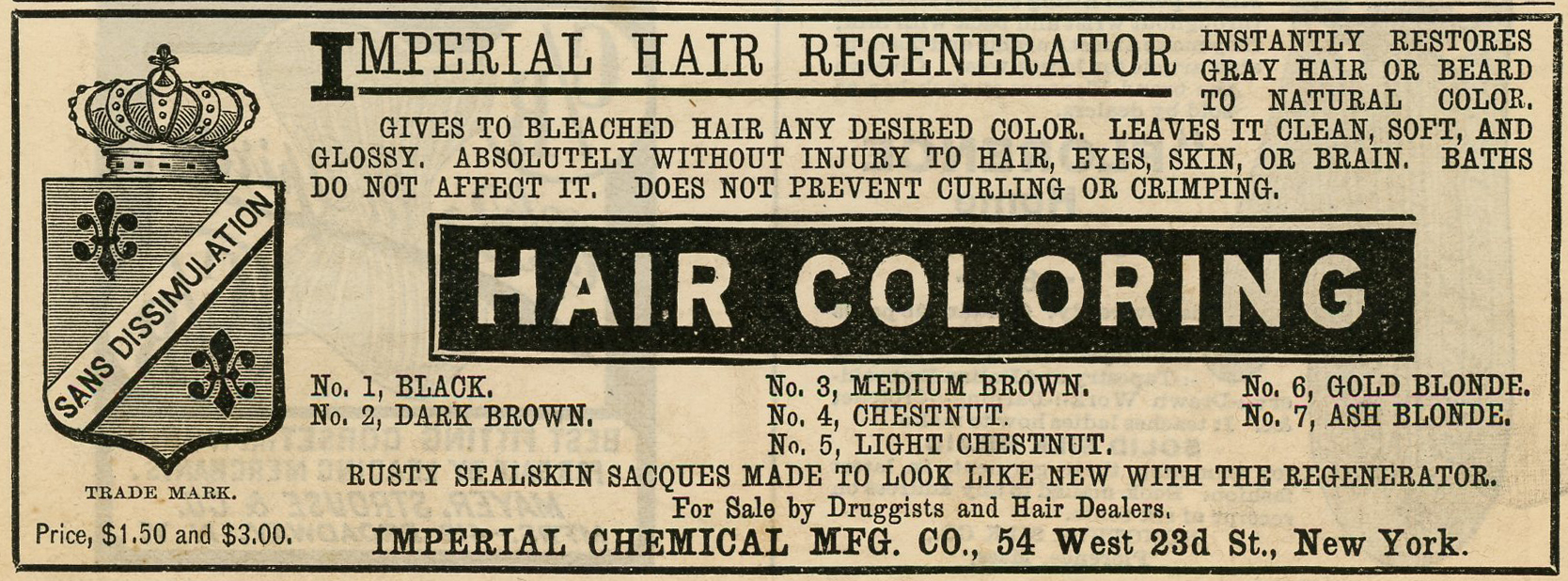
This is an advertisement for a hair and fur dye from 1885. A “sealskin sacque” was a popular style of jacket with a fur collar. Wilde has been photographed and painted in such a coat.
Regulation of products containing PPD did not begin until 1938, in the United States. Oscar Wilde lived in the UK and France several decades before that. The products Wilde used most likely contained a high level of PPD, and possibly metallic salts and other additives. The location of his rash would make sense as a reaction to PPD; dye can easily get on the face, chest, back, and arms if a person is applying it at home.
Henna for hair was available in western countries at this time as well. Proper techniques for mixing and applying henna were not yet known to those in western countries. The quality of the products would have been low, as well. Henna was advertised as an exotic product from far-off lands, which was greatly appealing to the people of that era. Women with red hair were seen as alluring. Most of the dancers and sex workers in Paris hennaed their hair to make themselves more beautiful and noticeable.
Lautrec himself was fascinated with women with hennaed hair. He painted them frequently. These women appear in his paintings with red, tangerine, and yellow hair similar to the colors of Wilde’s hair in Lautrec’s and Oppiso’s depictions of him. Lautrec spent much of his time with prostitutes and dancers who hennaed their hair. As Wilde and Lautrec were close friends, Wilde would have known them as well.
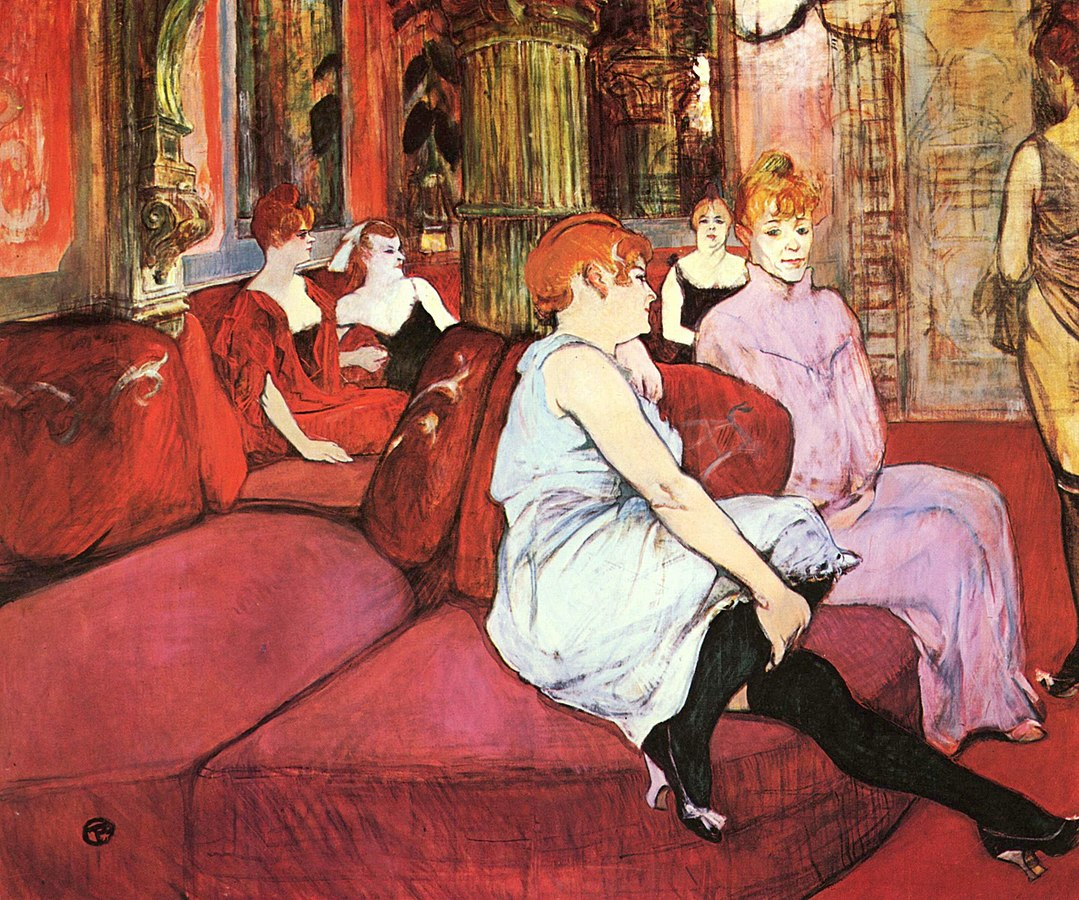
Notice that all of the women’s hair are shades of red.
Henri de Toulouse-Lautrec, “In the Salon of Rue des Moulins.”1894.
Source: https://commons.wikimedia.org/wiki/File:Henri_de_Toulouse-Lautrec_012.jpg
A woman named Jane Avril was a friend and muse to Lautrec, and a can-can dancer at the Moulin Rouge. There is no doubt that Jane Avril used henna. Lautrec painted her often for both portraits and posters. Her hair appears in shades from yellow to red, as well. Comparing Lautrec’s color choices for Avril’s hair, which was definitely hennaed, and Wilde’s, one can see that it is very likely that Wilde also used henna.

In this poster of Jane Avril, her hair is golden.
Henri de Toulouse-Lautrec, “Jane Avril.” 1899. Source: https://commons.wikimedia.org/wiki/File:Lautrec_jane_avril_(poster)_1899.jpg
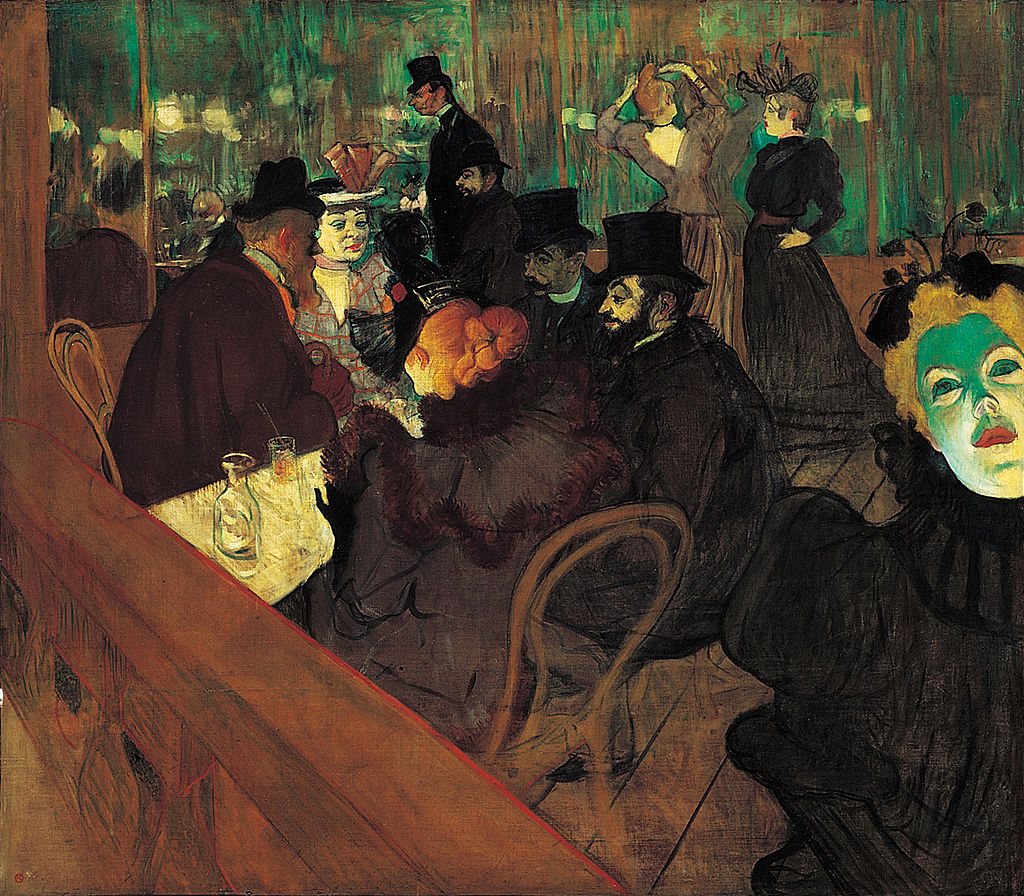
Lautrec paints himself sitting among his friends. At the center, Jane Avril’s bright orange hair grabs the viewer’s attention.
Henri de Toulouse-Lautrec, “At the Moulin Rouge” 1892/95.
Source: https://commons.wikimedia.org/wiki/File:Henri_de_Toulouse-Lautrec_-_At_the_Moulin_Rouge_-_Google_Art_Project.jpg
Henna for hair products were not much better than conventional dyes at the time. The products that were sold to the western world contained low quality henna and a myriad of additives. Techniques for henna mixing and application were also lacking. Henna mixed with boiling water produced a light, brassy result which faded. This could be a possible explanation for both Avril’s and Wilde’s variations in hair color.
If Wilde had a PPD sensitization, there is no indication that he made the connection between his rashes and his hair dye. Very little research had been done on PPD sensitization and the dangers of hair dye at the time. The early research and warnings came about in the early 1900s, after Wilde’s death. Wilde would not have thought, “It must be the PPD in the hair dye. I should try something else.” Nor would a doctor have recommended him to do so. It is unlikely that he chose henna as a safer alternative. Henna at the time contained metallic salts and possibly PPD.
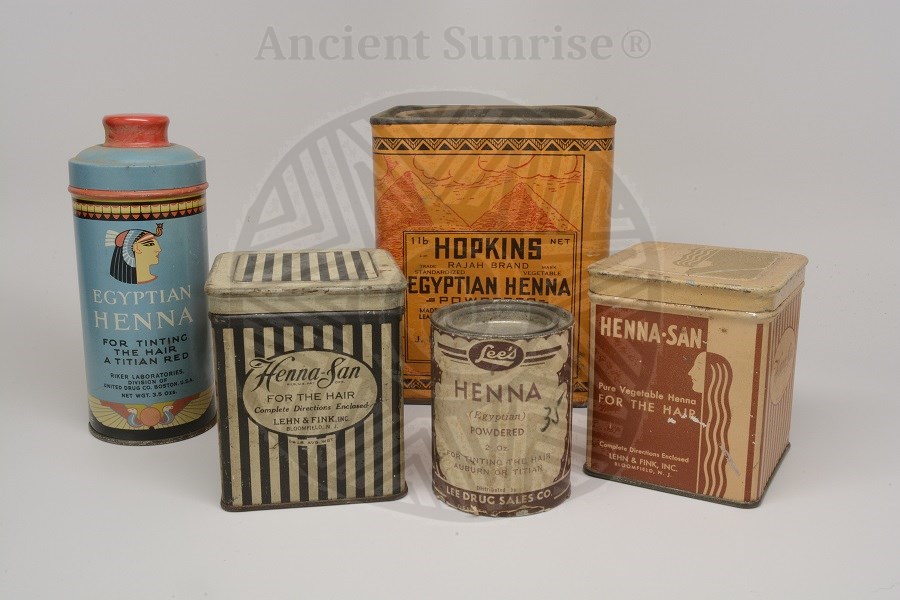
Examples of early henna for hair products. These would have been from the early half of the 1900s They often contained low quality, stale, chunky henna, other ingredients.
At any rate, Wilde thought little of doctors and their attempts to convince him to eat and drink less, and to exercise more. Wilde’s love of food and drink came before his concern for his personal health. Wilde equally loved youth and beauty. Because accounts show that his rash continued on and off until his death, it is more likely that Wilde continued to dye his hair, perhaps switching between conventional dyes and henna-based ones.
Additionally, there is no record of Wilde stating that he felt the rashes may have been from hair dye. Instead, he continued to think that the initial rash came from consuming bad mussels, and then popped up every so often after he indulged too much. “I’m alright, Frank,” He told his friend, “but the rash continually comes back, a ghostly visitant. It generally returns after a good dinner, a sort of aftermath of champagne.” [1]
This sort of reaction is not consistent with an allergy to mussels or seafood, unless the “good dinner” that preceded the rash always contained mussels. He did not say “It generally returns every time I eat more mussels.”
More likely is that Wilde experienced a delayed hypersensitivity reaction to PPD. Reactions to PPD do not always occur immediately after exposure. Medical professionals stress the importance of doing a delayed read of patch tests at 96 hours for this reason [3]. If Wilde expected to go out to enjoy a dinner or part with company, he might have dyed his hair the day before to ensure that his friends would not see any gray roots. By the day or two after the dinner, his rash would be present.
How Far Did the Allergy Go?
While his death is now believed to be the result of a chronic ear infection, some hypothesize that this could have been an extension of his allergy to PPD. While in prison, Wilde one day felt ill and fainted, and his ear bled. He reported that his ear continued to bleed and discharge afterwards. The condition worsened, causing partial deafness. He eventually had an operation performed by a doctor in his hotel room in Paris shortly before his death. Details are not known about the exact nature of this operation.
PPD can cause severe blistering and weeping sores on the skin. It is not impossible to think that if Wilde had managed to get hair dye into his ear earlier on, that is could have caused a reaction that continued to worsen, growing into an infection and collection of pus in the inner ear. The inside of the ear is a difficult place to clean, and as it is warm and damp, is an ideal place for infection to grow. Having blisters and weeping sores would have made the skin inside the ear particularly vulnerable to bacteria.
Final Notes
Because of the lack of medical records, Wilde’s unlikeliness to discuss personal health and grooming, and the inadequacy of medical knowledge during this time, it is impossible to determine for sure the cause of Wilde’s skin condition. However, there is enough evidence to believe that it was contact dermatitis caused by sensitivity to para-phenylenediamine in hair dye.
While it would have been wonderful to say, “Oscar Wilde knew the dangers of conventional hair dye and chose henna as a safe alternative,” there is simply no evidence behind this statement, and it would not fit into the facts of PPD knowledge and available henna products of the time. If he did use henna, it was simply because it was there. Henna for hair products at the end of the 19th century were not much safer, nor was the knowledge of proper mixing and application available in the west.
All that can be done is to piece together information from photography, art, letters, and accounts written by Wilde’s close associates. Having done this, the conclusion to be drawn is the following: Oscar Wilde definitely had premature gray hair; he definitely dyed his hair; he very likely had a PPD allergy; and he probably used henna, although not to replace PPD-based dyes.
Wilde, now loved for his writing and known for his flamboyant and rule-breaking ways, can be considered one of the first celebrities to become sensitized to para-phenylenediamine, and can tentatively hold a place in the hall of “hennaed divas.”
References
[1] Cawthorne, Terence. “The last illness of Oscar Wilde.” (1959): 123-127.
[2] Critchley, Macdonald. “OSCAR WILDE A MEDICAL APPRECIATION.” Medical history 1, no. 3 (1957): 199.
[3] Jacob, Sharon E., and Alina Goldenberg. “Allergic.”
[4] Nater, J. P. “Oscar Wilde’s skin disease: allergic contact dermatitis?.” Contact dermatitis 27, no. 1 (1992): 47-49.
